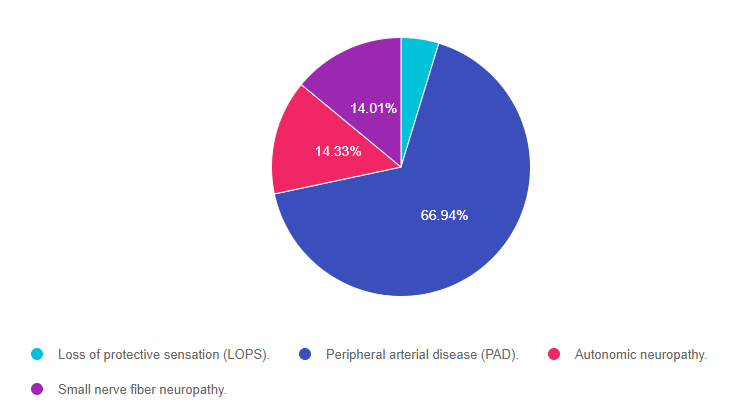
For last week’s practice question, we quizzed test takers on the cause of JR’s leg pain. 67% of respondents chose the best answer. We want to share this important information, so you can pass it on to people living with diabetes and your colleagues, plus prepare for exam success!
Before we start though, if you don’t want any spoilers and haven’t tried the question yet, you can answer below: Answer Question
Question: JR is experiencing lower extremity pain and asks to get their gabapentin (Neurontin) renewed? When asked, JR says the pain is so bad in their calf muscles when walking, that they have to sit down and rest. What best describes the cause of JR’s pain?
Answer Choices:
- Loss of protective sensation (LOPS).
- Peripheral arterial disease (PAD).
- Autonomic neuropathy.
- Small nerve fiber neuropathy.

As shown above, the most common choice was option 2, the second most common answer was option 3, then option 4, and then finally option 1.
Getting to the Best Answer
Answer 1 is incorrect. 4.72% chose this answer, “Loss of protective sensation (LOPS).” This is a juicy answer because people with neuropathy and loss of protective sensation are often prescribed gabapentin to treat nerve pain. However, when we learn that JR’s calf pain only occurs when walking, we experience an “ah-ha” moment. The cause of JR’s pain is lack of arterial blood flow to the lower extremities, also known as peripheral arterial disease (PAD). The classic symptom of PAD is pain in calf muscles or buttocks when walking that is relieved by stopping. Neuropathy is most often described as burning pain in lower extremities that is often worse at night.
Answer 2 is correct. 66.94% of you chose this answer, “Peripheral arterial disease (PAD).” JR is experiencing lack of arterial blood flow to the lower extremities, also known as peripheral arterial disease (PAD). A classic symptom of PAD is pain in calf muscles or buttocks when walking that is relieved by stopping. Perhaps JR was prescribed gabapentin due to an incomplete medical assessment. With this new information, we can collaborate with the provider to see if referral to a vascular specialist is warranted to evaluate if further intervention is needed.
Answer 3 is incorrect. 14.33% of respondents chose this answer, “Autonomic neuropathy.” Autonomic neuropathy in people with diabetes does not cause lower extremity pain. Lower extremity pain is due to small and large nerve fiber destruction or peripheral arterial disease (PAD). People with autonomic neuropathy and diabetes are at higher risk of gastroparesis, sexual dysfunction, resting tachycardia and a myriad of other conditions.
Finally, Answer 4 is incorrect. 14.01% chose this answer, “Small nerve fiber neuropathy.” This answer is tempting because people with small nerve fiber neuropathy are often prescribed gabapentin to treat nerve pain. However, when we learn that JR’s calf pain only occurs when walking, we experience an “ah-ha” moment. The cause of JR’s pain is lack of arterial blood flow to the lower extremities, also known as peripheral arterial disease (PAD). The classic symptom of PAD is pain in calf muscles or buttocks when walking that is relieved by stopping. Small nerve fiber neuropathy is most often described as burning pain that is often worse at night.
We hope you appreciate this week’s rationale! Thank you so much for taking the time to answer our Question of the Week and participate in this important learning activity!
Want to learn more about this question?
Watch our Lower Extremity Assessment Standards | Level 2
$29 for 1.5 CEs
Recorded & Ready to Watch!

People with diabetes are at increased risk of Lower Extremity Complications. This course reviews the steps involved in performing a detailed assessment of the lower extremities, including how to use a monofilament and tuning fork to detect neuropathy. We also discuss the significance of Ankle Brachial Index and strategies to prevent lower extremity complications.
Objectives:
- Describe the risk factors for lower extremity complications
- Discuss prevention strategies
- Demonstrate steps involved in a lower extremity assessment
Virtual DiabetesEd Specialist Conference
30+ CEs | April 13-15, 2022
Whether you are new to diabetes or a seasoned expert, you’ll benefit from this virtual conference with the latest research plus critical content that you can immediately apply to your clinical practice.
Download Course Schedule | Download Course Flyer
If you are seeking a state-of-the-art review of current diabetes care, this course is for you. Our team has been fine-tuning this course for over fifteen years, and we know what you need. This program can also be a great addition to your CDCES or BC-ADM exam study plan.
Join us LIVE for this Virtual Course and enjoy a sense of community!
Team of expert faculty includes:
- Diana Isaacs, PharmD, BCPS, BC-ADM, BCACP, CDCES – Educator of the Year, 2020
- Coach Beverly Thomassian, RN, MPH, CDCES, BC-ADM
- Ashley LaBrier, MS, RD, CDCES, Diabetes Program Coordinator
Two Registration Options
Virtual DiabetesEd Specialist Conference Deluxe | 30+ CEs
Deluxe Option for $499: Virtual Program includes:
- Q & A Session with the instructor after each webinar.
- LIVE Presentations by our team of experts.
- State of the art review of current diabetes care and technology.
- Resources for each session.
- Access to free podcasts and video recordings within a week of each live session for one year.
Deluxe Version includes Syllabus, Standards and Swag*:
- Diabetes Educator Course 2022 Syllabus Hard Copy – over 100 pages -This spiral-bound workbook contains the printed version of all of the instructor’s slides.
- ADA 2022 Standards of Care Book -The ADA Standards of Medical Care in Diabetes is a key resource for healthcare professionals involved in diabetes care, education, and support.
- DiabetesEd Services highlighters, Medication PocketCard, Tote Bag and Pen
Virtual DiabetesEd Specialist Conference Basic | 30+ CEs
Deluxe Option for $499: Virtual Program includes:
- Q & A Session with the instructor after each webinar.
- LIVE Presentations by our team of experts.
- State of the art review of current diabetes care and technology.
- Resources for each session.
- Access to free podcasts and video recordings within a week of each live session for one year.
Don’t worry if you can’t make it live. Your registration guarantees access to the recorded version in the Online University.
All hours earned count toward your CDCES Accreditation Information
Sign up for Diabetes Blog Bytes – we post one daily Blog Byte from Monday to Friday. And of course, Tuesday is our Question of the Week. It’s Informative and FREE! Sign up below!
The use of DES products does not guarantee the successful passage of the CDCES exam. CBDCE does not endorse any preparatory or review materials for the CDCES exam, except for those published by CBDCE.









